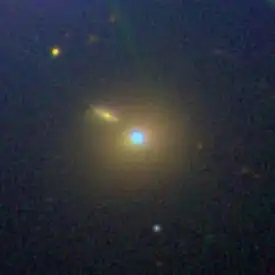Markarian 421
Markarian 421 (Mrk 421, Mkn 421) is a blazar located in the constellation Ursa Major. The object is an active galaxy and a BL Lacertae object, and is a strong source of gamma rays. It is about 397 million light-years (redshift: z=0.0308 eq. 122Mpc)[2] to 434 million light-years (133Mpc)[3] from the Earth. It is one of the closest blazars to Earth, making it one of the brightest quasars in the night sky. It is suspected to have a supermassive black hole (SMBH) at its center due to its active nature. An early-type high inclination spiral galaxy (Markarian 421-5) is located 14 arc-seconds northeast of Markarian 421.
| Markarian 421 | |
|---|---|
 Sloan Digital Sky Survey image of Mrk 421 | |
| Observation data (Epoch J2000) | |
| Constellation | Ursa Major |
| Right ascension | 11h 04m 27.314s[1] |
| Declination | +38° 12′ 31.80″[1] |
| Redshift | 0.030021[1][2] |
| Distance | 397-434 million light-years (122[2]-133[3] Mpc) |
| Type | BL LAC[1][2] |
| Apparent magnitude (V) | 12.9 (SIMBAD)[1] 13.3 (NED)[2] 11.6-16 (B Band)[4] |
| Other designations | |
| B2 1101+38, UGC 6132, PGC 33452, 2E 2393, QSO B1101+384, Mark 421[1] | |
| See also: Quasar, List of quasars | |
It was first determined to be a very high energy gamma ray emitter in 1992 by M. Punch at the Whipple Observatory,[5] and an extremely rapid outburst in very-high-energy gamma rays (15-minute rise-time) was measured in 1996 by J. Gaidos at Whipple Observatory [6]
Markarian 421 also had an outburst in 2001 and is monitored by the Whole Earth Blazar Telescope project.[7]
Due to its brightness (around 13.3 magnitude, max. 11.6 mag. and min. 16 mag.) the object can also be viewed by amateurs in smaller telescopes.
References
- "Mrk 421". SIMBAD Astronomical Database. Retrieved 2010-04-12.
- "NASA/IPAC Extragalactic Database". Results for MRK 0421. Retrieved 2010-04-12.
- "Distance Results for MRK 0421". NASA/IPAC Extragalactic Database. Retrieved 2010-04-13.
- "Variable Star Of The Season AAVSO. Winter 2004: Markarian 421". AAVSO. December 28, 2007. Retrieved 2010-01-10.
- Punch, M.; Akerlof, Carl W.; Cawley, M. F.; Chantell, M.; Fegan, D. J.; Fennell, S.; Gaidos, J. A.; Hagan, J.; Hillas, A. M.; Jiang, Y.; Kerrick, A. D.; Lamb, R. C.; Lawrence, M. A.; Lewis, D. A.; Meyer, D. I.; Mohanty, G.; Oflaherty, K. S.; Reynolds, P. T.; Rovero, A. C.; Schubnell, Michael; Sembroski, G. H.; Weekes, T. C.; Whitaker, T.; Wilson, C. (6 August 1992). "Detection Of Tev Photons From The Active Galaxy Markarian 421, Nature, Volume 358, Issue 6386, pp 477-478 (Aug. 6, 1992)". Nature. 358 (6386): 477. Bibcode:1992Natur.358..477P. doi:10.1038/358477a0. hdl:2027.42/62745. S2CID 4349393.
- Gaidos, J. A.; Akerlof, C. W.; Biller, S.; Boyle, P. J.; Breslin, A. C.; Buckley, J. H.; Carter-Lewis, D. A.; Catanese, M.; Cawley, M. F.; Fegan, D. J.; Finley, J. P.; Gordo, J. Bussöns; Hillas, A. M.; Krennrich, F.; Lamb, R. C.; Lessard, R. W.; McEnery, J. E.; Masterson, C.; Mohanty, G.; Moriarty, P.; Quinn, J.; Rodgers, A. J.; Rose, H. J.; Samuelson, F.; Schubnell, M. S.; Sembroski, G. H.; Srinivasan, R.; Weekes, T. C.; Wilson, C. L.; Zweerink, J. (1996). "Extremely rapid bursts of TeV photons from the active galaxy Markarian 421, Nature, Volume 383, Issue 6598, pp. 319-320 (1996)" (PDF). Nature. 383 (6598): 319. Bibcode:1996Natur.383..319G. doi:10.1038/383319a0. S2CID 4327435.
- Sillanpää, A.; Takalo, L. O.; Webt Collaboration (2001). "Optical monitoring of the blazar Mk421 during the TeV outburst". International Cosmic Ray Conference. 7: 2699. Bibcode:2001ICRC....7.2699S.
External links
- Markarian 421 on WikiSky: DSS2, SDSS, GALEX, IRAS, Hydrogen α, X-Ray, Astrophoto, Sky Map, Articles and images
- Focus on Markarian 421
- Gokus, Andrea; et al. (2021). "Multi-wavelength study of MRK 421 during a TeV flare". Proceedings of 37th International Cosmic Ray Conference — PoS(ICRC2021). p. 869. doi:10.22323/1.395.0869.